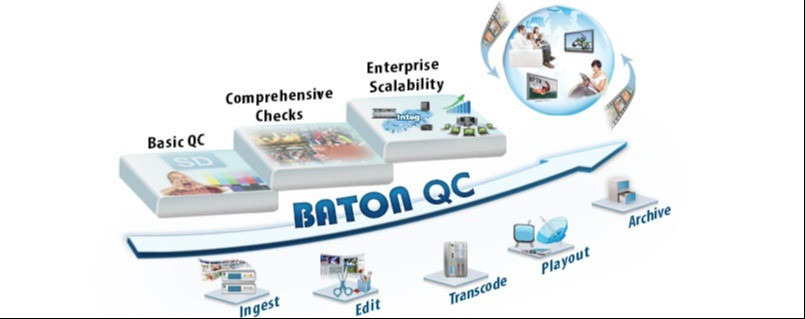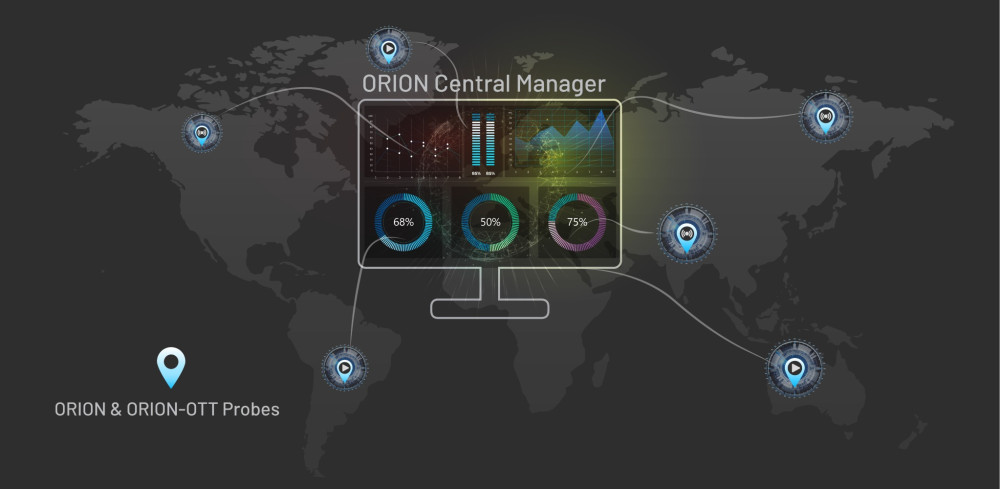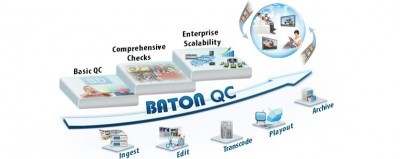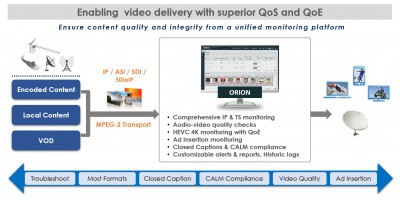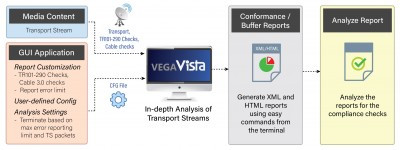The Anatomy of a Good QC Solution

Author: Bob Pank#
Published 1st December 2011
As the media transitions from tape-based analog to file-based digital content, the existing workflows and operational methods of media companies will need to be updated. File-based workflows are being widely adopted as mainstream solution by Broadcasters, Post-production houses, IPTV, satellite and archiving companies. A file-based content can be stored on traditional IT infrastructure, modified & analyzed by software and transferred via high-speed networks to Connected-consumers across multiple-screens for increased revenues. The pace and the freedom to change the file-based content can lead to various problems in content. Hence the content needs to be verified after every change. New generations of Quality Control (QC) solutions such as Interra’s Baton fulfill this need to verify the content at every stage. This article discusses the anatomy of a good QC solution.
File-based Content – QC Solution requirements
File-based content is processed through many stages from creation to archival. These stages are collectively called Content lifecycle stages. Content lifecycle stages commonly include Ingest, Edit, Transcode, Playout and Archival. At each stage, the content may be represented in certain formats and processed by a specialized infrastructure for a specific purpose. The subtle differences in formats support and the methods of processing at each stage can lead to unexpected problems in content. The QC solutions are expected to analyze such issues and ensure the content is verified to be ready at every stage of content lifecycle.
QC Across Content Lifecycle - At each stage of content lifecycle, the content needs to be verified (QC) for its internal details (formats, regulations, quality). Also at each stage, the type of content transformation is different - Editors change the content, Transcoders re-generate content and MAM solutions change header information. Hence there is a need for QC at every stage of content lifecycle for stage-specific verification. Also as the content size & volume grows, the efficiency of QC becomes an important requirement. Hence QC solutions have become a critical component throughout the file-based workflows as shown in the figure below:
For media companies that have multiple sites/business units, consistent QC methods across their business units’ help maximize their operational efficiencies. The growing global market of connected consumers also creates opportunities for media companies to consume content from any global supplier or supply content to any global consumer. The expanded content diversity and exchange further adds to the depth & breadth of QC requirements.
Anatomy of a good QC solution - A good QC solution needs to address multiple requirements in step with growing content and the diverse needs of media companies:
1. Content-specific requirements – Does the QC solution offer a complete solution to verify a wide-range of content formats, delivery standards, regulatory compliance and quality at every stage of content lifecycle
2. Efficiency & throughput requirements – Can the QC solution offer facilities to improve verification efficiency as the content size & volume increases?
3. Enterprise-wide scalability requirements – Can the QC solution enable enterprise-wide groups achieve consistent and reliable QC methods?
4. Global supply-chain requirements – Can the QC solution help expand content monetization in global markets as a trusted content certifier for suppliers and consumers
The following figure illustrates the four categories of requirements of a good QC solution:
QC Solution requirements – details
QC Solution requirement – 1: Content-specific requirements
A good QC solution should be able to support a wide-variety of content-specific requirements so the media companies can deal with any content at any stage of content lifecycle. The content-specific aspects include the following:
a) Formats check – to make sure the content is in the formats it is supposed to be? The formats include the Container (MXF, LXF. Mov etc), Video essence (MPEG-2, H.264, J2K, DV etc) and Audio essence (AC-3, Dolby-E, WAV, MP3 etc). The QC solution should be able to handle format variations from various sources and still be able to check for format compliance to standard. An example of a standard format with many variations across infrastructure is MXF.
b) Delivery check – The content needs to comply with delivery standards such as CableLabs VOD and ARIB depending on the region.
c) Regulatory compliance check - In some regions of the world, content must be compliant with certain regulations. Notable regulations include loudness and flashiness control. Regulatory compliance checks are easy to support as they are well-defined in standards and are enforced only in some regions. For content targeted to broader global regions, regulatory compliance is not a major issue.
d) Quality checks – As the content is transformed from each stage to another, its quality can be impacted. Common quality problems include freeze frames, black frames, blurriness, audio silence and many more. Some quality problems impact the viewer experience while others can lead to operational glitches (freeze frames). A good QC solution should be able to handle a multitude of quality problems and assess the problems correctly. Many QC solutions offer quality checks but few are able to offer correct assessment of the quality errors.
QC Solution requirement – 2: Efficiency & throughput requirements
File-based content is growing rapidly and QC of the growing content needs to be optimized with the customer’s existing computing resources. The QC solution should offer facilities so the verification can be made efficient. These facilities include partial verification (verify only problem areas), growing-file verification (verify as the file is being downloaded and reject download if there is a problem) and allocation of compute power to relevant QC purposes (large content vs high-volume content). Such efficiency and throughput facilities in a QC solution can help media companies scale their content QC seamlessly.
QC Solution requirement – 3: Enterprise-wide scalability requirements
A common challenge across Enterprise-wide groups is consistency. When multiple groups across an Enterprise deploy their File-based QC solution, are they consistent in their content QC? Are they using same criteria to verify each content type? Any divergence in their approaches can lead to incompatibilities in content exchange within the enterprise itself and lead to inefficiencies. As the content QC grows into a large operation, there will be a need to ensure un-interrupted operation of QC farms. Such reliability is provided by capabilities such as high-availability. QC solutions need to support enterprise wide consistency and reliability as the customer requirements grow.
QC Solution requirement – 4: Global Supply-chain requirements
The ease of localizing file-based content offers the potential to quickly expand to global markets and maximize the content monetization potential. It is common to see same programs in multiple regions with local language sub-titling and editing to comply with local regulations. In a global market of multiple suppliers and consumers, there is a need for objective QC of content for better interoperability and quality. A good QC solution should be able to verify a globally diverse content but also the localization of content for each region. Such verification will lead to faster content exchange across more suppliers and consumers.
Summary
Media companies are actively moving to digital media and File-based workflows to leverage their content and reach connected-consumers world-wide. As the file-based content is exchanged across the growing content suppliers-consumers, it needs to be verified for quality. New generation of Quality Control (QC) solutions such as Interra’s Baton fulfill the need for content verification. The QC solution requirements start with comprehensive content checks for formats, delivery standards, regulations and quality. The requirements continue to grow with emerging standards, variations in content transformation for a wide-variety of suppliers-consumers world-wide. A good QC solution should address existing requirements and continue to support the ever-changing eco-system of formats and quality issues.





